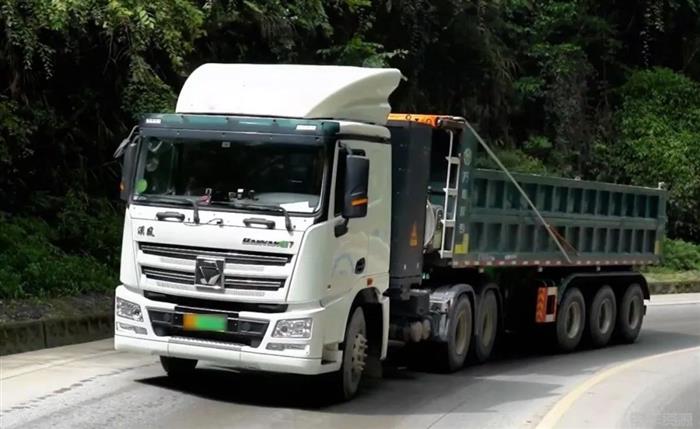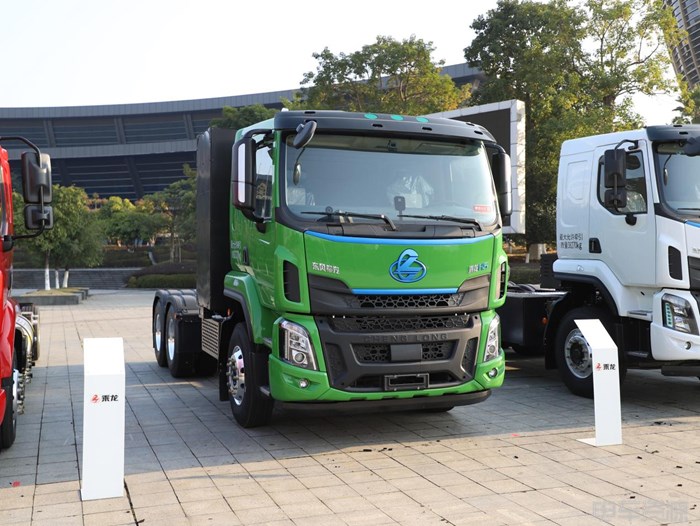Who Can Break the Legend of the "Short Haul King" for Electric Heavy Trucks?
From January to August 2025, sales of new energy heavy trucks reached 114,353 units, a year-on-year increase of 178.84%, with a market penetration rate exceeding 20%. Among them, electric heavy trucks accounted for 112,089 units, making up 98% of the total. New energy heavy trucks (mainly electric heavy trucks) are becoming one of the preferred models for logistics and transportation companies.
The development momentum of electric heavy trucks is strong, and they have already become the first choice for logistics and transportation companies in short-haul transportation, gradually becoming the main force in transportation. However, in the field of heavy truck transportation, medium and long-distance transportation is the key battleground that determines success.
It is understood that heavy-duty trucks account for over 60% of the entire heavy-duty truck market in the medium and long-distance transportation sector. How electric heavy-duty trucks can overcome the refueling bottleneck in medium and long-distance transportation has become a focus of industry concern, and refueling efficiency remains a key bottleneck restricting their widespread promotion.

Electric heavy trucks become the "short-dump king."
According to research on green heavy-duty trucks and combined with the actual application of electric heavy-duty trucks in short-distance transportation scenarios, electric heavy-duty trucks have demonstrated significant economic and operational advantages within a one-way distance of 300 kilometers for short-distance transportation. This is especially true for high-frequency round-trip routes in ports, mines, and steel mills, where their usage exceeds 50%.
In medium to long-distance trunk transportation with a unilateral distance exceeding 500 kilometers, electric heavy-duty trucks are still in the pilot operation stage and have not formed a scaled application. The main reasons for this phenomenon are several.
One issue is the insufficient layout of energy replenishment infrastructure, as electric heavy-duty trucks typically require 1 to 2 hours for a single charge, which is challenging to meet the demands of efficient operations.
Secondly, the endurance of the vehicles is limited. The existing battery technology has high energy consumption under heavy load and long-distance conditions, making it difficult to meet the actual demand for a single range of over 500 kilometers, and achieving over 1000 kilometers of ultra-long range is even more challenging.
Thirdly, the operational efficiency and cost pressure, as frequent charging reduces transportation timeliness, affecting drivers' enthusiasm for taking orders.
Fourth, there is the issue of "tonnage loss" in vehicles. The weight of the batteries in electric heavy-duty trucks can reach 3 to 5 tons (the weight varies depending on the battery capacity), which reduces the effective payload and further compresses profit margins. This is particularly detrimental in the transportation market where charges are based on tonnage, as "tonnage loss" directly undermines the economic advantages of electric heavy-duty trucks.
To address the aforementioned issue and improve the endurance of electric heavy trucks, increasing electric heavy trucks has become the first choice. According to Green Heavy Truck statistics, since 2024, the proportion of electric heavy trucks with a capacity of 282kWh (generally referring to this type of product) has sharply declined. By 2025, the proportion of 282kWh models has fallen to less than 10%, while models with a capacity of 400kWh or 423kWh account for over 30%, and models with a capacity of over 500kWh continue to increase, reaching a proportion of 20%. There are also a few models of electric heavy trucks with an 800kWh capacity in operation.
The introduction of high-capacity electric heavy-duty trucks has extended their range and improved operational efficiency, but the issue of "deadweight loss" remains unresolved. The problem of energy replenishment efficiency persists; even with increased battery capacity, the time required for recharging cannot be easily reduced to an ideal range. This constrains the pace of medium- to long-distance trunk line transportation, limiting it to a barely sustainable pilot operation scale.

Fast Charging + Battery Swapping Assist Electric Heavy Trucks in Long-Distance Travel
Running long distances is the key for electric heavy trucks to truly become the main force in transportation. Improving energy replenishment efficiency is the core to unlocking medium and long-distance transportation, with ultra-fast charging and battery swapping becoming the two major technical paths.
High-power supercharging can reduce the charging time to under 30 minutes, significantly enhancing operational continuity in conjunction with the layout of the charging network along the route.
According to reports, the latest released megawatt-level ultra-fast charging technology allows electric heavy trucks to charge with 1-1.6MW liquid-cooled ultra-fast charging piles, extending the range by over 300 kilometers in just 30 minutes, significantly improving charging efficiency.
The price of liquid-cooled supercharging stations is expensive, and for electric heavy truck operations that pursue cost-effectiveness, large-scale promotion costs are too high. Additionally, the strict demands on power grid load make widespread adoption challenging in the short term. Moreover, vehicles and battery systems require adaptation and upgrades to withstand the thermal management pressure and lifespan degradation issues caused by high-rate charging. This will increase the vehicle purchase cost, further restricting the comprehensive implementation of supercharging technology.
The battery swapping model utilizes the "Battery as a Service" concept to achieve separation of the vehicle and battery, allowing for rapid replacement and completing energy replenishment within 5 to 10 minutes, significantly improving vehicle attendance rates. Standardized battery packs are compatible with multiple vehicle models, reducing the initial investment for operators and alleviating the pressure of "loss of tonnage."
Battery swapping models face numerous challenges: the lack of standardized batteries makes it difficult for different brands to exchange batteries at various swapping stations; the initial investment and construction costs for swapping stations are high, the return cycle is long, and insufficient network coverage restricts large-scale development; moreover, under the vehicle-battery separation model, the ownership and responsibility of the batteries are unclear, affecting insurance pricing, residual value assessment, and the attribution of maintenance responsibilities, which limits user acceptance.
According to research, the number of completed battery swap stations for heavy trucks has exceeded 2,000, primarily distributed in closed environments such as mines, ports, and steel mills in the short-haul transportation sector. However, the layout of battery swap stations along open road trunk transportation routes remains sparse, with even fewer stations along main lines spanning over 500 kilometers, making it difficult to form an efficiently connected battery swap network, which restricts the feasibility of cross-regional transportation for electric heavy trucks.
Supercharging can quickly improve energy replenishment efficiency, but it is limited by costs and grid pressure, making it difficult to fully roll out in the short term. The battery swapping model, although it offers rapid energy replenishment and high attendance rates, is constrained by inconsistent standards and sparse networks. Both have their advantages and disadvantages. In practical operations, a strategy of "scenario adaptation and collaborative complementarity" can be adopted.
For mature transport routes, priority should be given to the layout of battery swapping networks, leveraging high-frequency and stable traffic flow to enhance station utilization and reduce the cost of each energy replenishment. In hub nodes with strong grid capacity and ample land resources, high-power ultra-fast charging stations should be set up as a supplement to meet temporary charging needs. Through a flexible combination mode of "swap when possible, charge when necessary," we can both leverage the efficient advantages of battery swapping and utilize the flexibility of ultra-fast charging infrastructure to respond to sudden demands, promoting the long-distance operation of electric heavy-duty trucks.

Long-haul electric heavy trucks are imperative, and building an efficient and sustainable energy replenishment ecosystem is key. We need to anchor on actual operational scenarios, promote the coordinated development of ultra-fast charging and battery swapping, break the isolation of energy replenishment, overcome the barriers of cross-regional transportation, and achieve the green transformation of long-haul trunk line transportation.
【Copyright and Disclaimer】The above information is collected and organized by PlastMatch. The copyright belongs to the original author. This article is reprinted for the purpose of providing more information, and it does not imply that PlastMatch endorses the views expressed in the article or guarantees its accuracy. If there are any errors in the source attribution or if your legitimate rights have been infringed, please contact us, and we will promptly correct or remove the content. If other media, websites, or individuals use the aforementioned content, they must clearly indicate the original source and origin of the work and assume legal responsibility on their own.
Most Popular
-

List Released! Mexico Announces 50% Tariff On 1,371 China Product Categories
-

EU Changes ELV Regulation Again: Recycled Plastic Content Dispute and Exclusion of Bio-Based Plastics
-

Case Study | Clariant AddWorks™ Additives Solve Plastic Yellowing Problem
-

Mexico officially imposes tariffs on 1,400 chinese products, with rates up to 50%
-

Wanhua Chemical Transforms Annual Production of 60,000 Tons PBAT Facility to Produce PETG






